
Christ Church Watney Street (1841 – 1951)
WHAT A LONDON CURATE CAN DO IF HE TRIES
 Three
of the sons of William Quekett, the master of Langport grammar school
in Somerset from 1790-1842, achieved a measure of fame: Edwin John and
John Thomas Quekett, as histologists and microscopists, and their older brother
William Quekett
(1802-88). He had studied at St John's College Cambridge,
reading as widely as possible (he attended lectures on fen drainage),
and was ordained in 1825, serving at South Cadbury, in the diocese of
Bath
and Wells. He was by conviction an Evangelical. Four years later a
friend told him there was a post as curate and Lecturer at St
George's. He came for interview, only to discover, as his cab drove on, that it was not St
George Hanover Square, as he had thought, but the more challenging
situation of St George-in-the-East. [This is a recurring error: various
websites implausibly claim that Edward William Spencer Cavendish, 10th
Duke of Devonshire (1895-1950), was born in this parish despite the
family's links being with the other church.] To his credit, he stayed
anyway,
and achieved great things in his 24 years here (curate 1830-41,
incumbent of Christ Church 1841-54). He was applauded in
Charles Dickens' Household
Words (16 November 1850) in an
article 'What a London curate can do – if he tries' which you can read here. It
includes an account of the curious circumstances of his appointment.
Three
of the sons of William Quekett, the master of Langport grammar school
in Somerset from 1790-1842, achieved a measure of fame: Edwin John and
John Thomas Quekett, as histologists and microscopists, and their older brother
William Quekett
(1802-88). He had studied at St John's College Cambridge,
reading as widely as possible (he attended lectures on fen drainage),
and was ordained in 1825, serving at South Cadbury, in the diocese of
Bath
and Wells. He was by conviction an Evangelical. Four years later a
friend told him there was a post as curate and Lecturer at St
George's. He came for interview, only to discover, as his cab drove on, that it was not St
George Hanover Square, as he had thought, but the more challenging
situation of St George-in-the-East. [This is a recurring error: various
websites implausibly claim that Edward William Spencer Cavendish, 10th
Duke of Devonshire (1895-1950), was born in this parish despite the
family's links being with the other church.] To his credit, he stayed
anyway,
and achieved great things in his 24 years here (curate 1830-41,
incumbent of Christ Church 1841-54). He was applauded in
Charles Dickens' Household
Words (16 November 1850) in an
article 'What a London curate can do – if he tries' which you can read here. It
includes an account of the curious circumstances of his appointment.
The
elderly Rector, Dr Farington, in post since 1802, was unsupportive of
Quekett's efforts, being content to leave
the parish as he found it rather than tackle its huge social
problems. Quekett's first project was to fit out as boys,
girls and infants schools three
arches
east of Cannon Street Road under the
viaduct of the new London and Blackwall Railway: further details here.
Building
a new church in the parish had been mooted in 1831
by the Church Building Commissioners, and by the Bishop of London in
1837 (who hoped for three others in Stepney), but all depended on local
initiative, and the Rector argued that church rate had to be spent on
the newly-purchased extension to the burial ground and on church restoration, so no
funds were available. But in
1838 a local builder, George Bridger, offered the CBC the sites of
three houses in Watney Street, which he held on lease from the
Mercers' Company. He was willing to make a gift of these leaseholds,
valued at £1,130, paying the Mercers £350 for the
freehold, and compensation of £35 to the tenants, on three
conditions:
-
it
should designed by John Shaw junior
- it
should be built by himself, and
- there
should be no burial ground.
 The
CBC agreed; the site was conveyed to them on 27 March 1839. A
foundation stone was laid on 11 March 1840, and Messrs George &
James Weddell Bridger, of Aldgate Street, built the church, which was
consecrated on 3 May 1841, with 1200 sittings. The total cost to the
CBC was £7,251 9s. 11d. including the site (which in the
event
they rather than Bridger bought). In 1845 two adjacent houses were
adapted to provide a vicarage, adding a hall and four large
rooms at a cost of £1,400; Quekett's
children laid
the foundation stone (his wife Harriet [left] died in 1849, aged 37). He had
previously lived at 51 Wellclose
Square - with his scientist brothers at number 50.
The
CBC agreed; the site was conveyed to them on 27 March 1839. A
foundation stone was laid on 11 March 1840, and Messrs George &
James Weddell Bridger, of Aldgate Street, built the church, which was
consecrated on 3 May 1841, with 1200 sittings. The total cost to the
CBC was £7,251 9s. 11d. including the site (which in the
event
they rather than Bridger bought). In 1845 two adjacent houses were
adapted to provide a vicarage, adding a hall and four large
rooms at a cost of £1,400; Quekett's
children laid
the foundation stone (his wife Harriet [left] died in 1849, aged 37). He had
previously lived at 51 Wellclose
Square - with his scientist brothers at number 50.
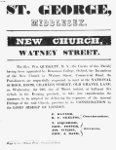 Although
he had built the church and was presented to the living, pew rents were
the only source of income, so for a while he retained his post at St
George's, working both churches with a fellow-curate John Sanders, until the death of
Dr Farington and the installation of Bryan King, after which he was
formally installed. He
set to work to raise £350 for fixtures, fittings
and a heating system. He bought an organ, insuring his life for
£100
as security for the balance - handbill right.
Although
he had built the church and was presented to the living, pew rents were
the only source of income, so for a while he retained his post at St
George's, working both churches with a fellow-curate John Sanders, until the death of
Dr Farington and the installation of Bryan King, after which he was
formally installed. He
set to work to raise £350 for fixtures, fittings
and a heating system. He bought an organ, insuring his life for
£100
as security for the balance - handbill right.
The Era announced on 31 October 1841 a magnificent organ, from the factory of Messrs. Gray and Davison, New-road, was opened last week at Christ Church, St.-George's-in-the-East, by Mr. Thomas Adams, in the presence of upwards of 2000 persons ... In December 1841 it announced (though mis-naming the church as 'St George-in-the-Fields') that Edward Cruse (b.1807) had been appointed organist. He had already published well-reviewed psalm chants and settings, and went on to produce other liturgical music, and to serve at the ritualistic church of St Barnabas Pimlico, whose current organist David Aprahamian Liddle is working on a biography of his predecessors, and has kindly provided us with information about Cruse. His successor two years later was the young prodigy William Rae (1827-1903) - see ch 7 here - appointed at the age of sixteen, an enthusiast for the music of Mendelssohn (whose oratorio St Paul was performed at the church). He was a pupil of William Sterndale Bennett, and, after a period at St Andrew Undershaft, went on to study in Leipzig and Prague. From 1860 he became became a key figure in the musical life of Newcastle-upon-Tyne.
Quekett borrowed communion plate; but on Christmas Day 1843 a cab drew up at his house, leaving a box containing an anonymous gift of silver vessels. The paten was engraved A QUIBUSDAM EXTERNIS QUI NOMINARI NOLUNT - 'from certain outsiders who do not wish to be named'. (Sadly they were stolen in 1890.)
In 1847 he contributed to a survey carried out by the Statistical Society of London (founded in 1834, now the Royal Statistical Society)
which detailed housing conditions, rents and wages. Batty's Gardens,
between Backchurch Lane and Berners [now Henriques] Street was
described thus: Many of the houses
in this street have no back premises, neither light nor ventilation
from behind, and consequently are close, damp and unhealthy ... at one
corner of the narrow part is a dust heap on which is thrown night-soil
and refuse of every description, which saturates and penetrates through
the walls to the premises behind, creating a most disgusting nuisance
to the tenants... Its 'solution' to the area's problems was ... since
the population is, to some extent, the drainage from the grades next
above them, we should rather hope to find a cure by cutting off the
supply of degradation than by attempting to reform and elevate it in
the lowest depths to which it can sink. Quekett, however, had other ideas.
The
1851 census showed the population of the
parish
to be 12,497, in 1,664 households - an average per 'house' (in
some cases, a single room) of 7.51 (in two Whitechapel parishes, the
average was over 9 per household). Quekett, however, gave higher
figures: a population of 17,124 in 2618 households, across 77 streets
and courts, with 50 brothels, 21 pubs and 22 beer shops. The district, he said,
covered 63 acres; the average rent of a house was low, at
£8.10s. a
year.
Many other
projects followed:
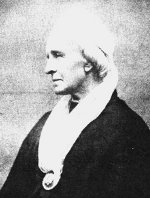 Quekett
took up the cause of 'distressed needlewomen' - exploited pieceworkers,
single women with and without children, for whom job opportunities were
very limited (see some statistics here) - and saw assisted emigration to the colonies, to address
the inbalance of men there, as a solution (as did Charles Dickens);
together with Sidney Herbert MP he founded the Female
Emigration Society
in 1849; he served on the committee, as did W.W. Champneys, the Rector
of Whitechapel, and another local priest, the Revd B.C. Sangar.
A fellow-enthusiast was the Hon. Mrs Jane Stuart-Wortley [right],
wife of the
Recorder of London (son of Lord Wharncliffe, and an MP, unexpectedly
appointed to this post in 1851); she maintained a keen interest in
Christ
Church until her death in 1900, and writes here
about 'emigration work'. She paid for a nurse for the sick-poor in the parish, and was one of the founders of the East
London Nursing Society, set up in 1868 in the wake of the
cholera epidemic. The charity continues, with one of our
congregation a trustee.
Quekett
took up the cause of 'distressed needlewomen' - exploited pieceworkers,
single women with and without children, for whom job opportunities were
very limited (see some statistics here) - and saw assisted emigration to the colonies, to address
the inbalance of men there, as a solution (as did Charles Dickens);
together with Sidney Herbert MP he founded the Female
Emigration Society
in 1849; he served on the committee, as did W.W. Champneys, the Rector
of Whitechapel, and another local priest, the Revd B.C. Sangar.
A fellow-enthusiast was the Hon. Mrs Jane Stuart-Wortley [right],
wife of the
Recorder of London (son of Lord Wharncliffe, and an MP, unexpectedly
appointed to this post in 1851); she maintained a keen interest in
Christ
Church until her death in 1900, and writes here
about 'emigration work'. She paid for a nurse for the sick-poor in the parish, and was one of the founders of the East
London Nursing Society, set up in 1868 in the wake of the
cholera epidemic. The charity continues, with one of our
congregation a trustee.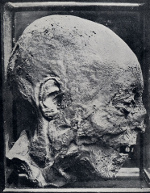 In
1851 he was
consulted by the incumbent of Holy Trinity, Minories over a mummified
head, found in its vaults (preserved in tannin-impregnated
sawdust); he said It
looked just like a New Zealand chief's head of which I had seen a
great many. The countenance expressed great agony; the eyes, the
teeth, the beard were perfect; and at the back of the head a very
deep cut was visible above the one that separated the head from the
body. He
referred it to Lord Dartmouth, whose family was responsible for the
church, and who claimed it was that of a family member who had
survived the first blow of the executioner's axe - but the legend that
it was the head of the Duke of Suffolk came later. (Holy Trinity closed
in 1899 and was joined to St Botolph Aldgate, where the head was buried
some time after the Second World War.)
In
1851 he was
consulted by the incumbent of Holy Trinity, Minories over a mummified
head, found in its vaults (preserved in tannin-impregnated
sawdust); he said It
looked just like a New Zealand chief's head of which I had seen a
great many. The countenance expressed great agony; the eyes, the
teeth, the beard were perfect; and at the back of the head a very
deep cut was visible above the one that separated the head from the
body. He
referred it to Lord Dartmouth, whose family was responsible for the
church, and who claimed it was that of a family member who had
survived the first blow of the executioner's axe - but the legend that
it was the head of the Duke of Suffolk came later. (Holy Trinity closed
in 1899 and was joined to St Botolph Aldgate, where the head was buried
some time after the Second World War.)
When Quekett left in 1854, the parish was served by a curate, two scripture readers and fourteen district visitors. The Sunday School had 25 teachers. He was rewarded, on the nomination of Lord Aberdeen, with the rich living of Warrington, whose previous rector, the Hon. Horatio Powys, has been made Bishop of Sodor and Man. By strange coincidence, Robert Farington's father had been Rector here 80 years previously, and the one book Quekett was given from Farington's library was a copy of his father's Warrington sermons. There, at St Elphin's, he built what was then the tallest spire in the north-west at 281 feet. He died in office, on Good Friday, 34 years later.
You can read some extracts from his gossipy autobiography My Sayings and Doings and a Reminiscence of My Life (Kegan Paul, Trench 1888) here (with links to further passages on particular topics). One final oddity about Quekett, which his book does not mention, is that in 1833 he had been appointed as the last rector of Goose Bradon, a sinecure parish in Hambridge (it was an abandoned medieval village with neither populuation nor a church) in his former diocese of Bath and Wells. Was this purely honorific, or did it produce a stipend? How did he square this with his opposition to lazy absentee clergy?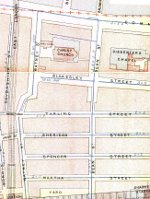 Right is the Vestry map of 1878 showing the location of church and vicarage, and part of its parish.
Right is the Vestry map of 1878 showing the location of church and vicarage, and part of its parish.THE CHURCH BUILDING

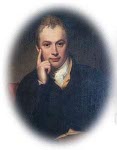 John
Shaw junior (1803-70) - left - was the son of John Shaw
(1776-1832) who had
been articled to George Gwilt the
Elder, and was the architect of St Dunstan
Fleet Street - see here
for details of links between the Gwilt and Shaw families, and that of
Dr Mayo, Rector of St George-in-the-East in the latter part of the 18th
century. Shaw junior had worked on Christ's Hospital. Christ
Church was in the 'Lombardic' Romanesque (or 'Round') style, in grey
bricks with
stone
dressings, with slated pyramid spires on the two west end towers.
Inside, he addressed one of chief chief architectural problems of the
age – providing maximum seating without ugly wooden galleries
–
by creating in the nave an arcade of two tiers of round-headed
arches, the upper one like a triforium containing the galleries, with
a clearstorey above (a solution that can be found elsewhere).
John
Shaw junior (1803-70) - left - was the son of John Shaw
(1776-1832) who had
been articled to George Gwilt the
Elder, and was the architect of St Dunstan
Fleet Street - see here
for details of links between the Gwilt and Shaw families, and that of
Dr Mayo, Rector of St George-in-the-East in the latter part of the 18th
century. Shaw junior had worked on Christ's Hospital. Christ
Church was in the 'Lombardic' Romanesque (or 'Round') style, in grey
bricks with
stone
dressings, with slated pyramid spires on the two west end towers.
Inside, he addressed one of chief chief architectural problems of the
age – providing maximum seating without ugly wooden galleries
–
by creating in the nave an arcade of two tiers of round-headed
arches, the upper one like a triforium containing the galleries, with
a clearstorey above (a solution that can be found elsewhere).
 In
a letter to Bishop Blomfield about a new church in Bethnal Green, John
Shaw argued that the Romanesque (rather than the Gothic) option contains
in an eniment degree the qualities now so important. These appear to
be, first, economy; secondly, facility of execution; thirdly, strict
simplicity combined with high capability of ornament; fourthly,
durability; fifthly, beauty (quoted in Kathleen
Curran The Romanesque Revival:
Religion, Politics and Transnational Exchange, Penn State
Press 2003, p206). The
undisguised brick and iron columns of Christ Church were an example of
this. However, another view was that this was a building of startling ugliness, with cast-iron pillars and Norman arches of grimy brick.
In
a letter to Bishop Blomfield about a new church in Bethnal Green, John
Shaw argued that the Romanesque (rather than the Gothic) option contains
in an eniment degree the qualities now so important. These appear to
be, first, economy; secondly, facility of execution; thirdly, strict
simplicity combined with high capability of ornament; fourthly,
durability; fifthly, beauty (quoted in Kathleen
Curran The Romanesque Revival:
Religion, Politics and Transnational Exchange, Penn State
Press 2003, p206). The
undisguised brick and iron columns of Christ Church were an example of
this. However, another view was that this was a building of startling ugliness, with cast-iron pillars and Norman arches of grimy brick.
 Originally,
the altar, surrounded by rails, stood against the east wall (behind
which was the only vestry). But in 1870 the architect James Brookes (1825-1901) opened a
round-headed arch in the east wall to add a large apsidal chancel. He
formed a choir in the first bay of the nave, and designed a
decorative scheme which was completed by 1885 [1870 plan, ICBS 07172, left].
Originally,
the altar, surrounded by rails, stood against the east wall (behind
which was the only vestry). But in 1870 the architect James Brookes (1825-1901) opened a
round-headed arch in the east wall to add a large apsidal chancel. He
formed a choir in the first bay of the nave, and designed a
decorative scheme which was completed by 1885 [1870 plan, ICBS 07172, left].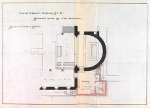
 New vestries were added
in 1894-96 [ICBS plan 09835, architect E.M.S. Pilkington], the former vestry becoming a side chapel - this altar [right] is now in the side chapel at St George-in-the-East.
New vestries were added
in 1894-96 [ICBS plan 09835, architect E.M.S. Pilkington], the former vestry becoming a side chapel - this altar [right] is now in the side chapel at St George-in-the-East. NINETEENTH CENTURY MINISTRY
See here
for details of the many curates who served in the parish, and here for statistics from the registers.
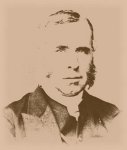 As
the district had been carved out of St George-in-the-East, Brasenose
College Oxford acquired the patronage, and they appointed a former
Scholar as Quekett's successor. George Henry McGill
(1854-67)
was from an old Irish family but was born in Manchester, son of a pawnbroker, and attended
Manchester Grammar School. Ordained in 1841, he had served curacies in Stockport, Edale,
Stepney and Hilgay in Norfolk, and been Vicar of Stoke Ferry, Norfolk
(a Lord Chancellor's living), where he rebuilt the church and was an
active member of the Norfolk & Norwich Archaeological Society, with
papers on 'The Easter Sepulchre at Northwold' and 'Oxborough Hall'
appearing in vol 4 of their Transactions (1855).
As
the district had been carved out of St George-in-the-East, Brasenose
College Oxford acquired the patronage, and they appointed a former
Scholar as Quekett's successor. George Henry McGill
(1854-67)
was from an old Irish family but was born in Manchester, son of a pawnbroker, and attended
Manchester Grammar School. Ordained in 1841, he had served curacies in Stockport, Edale,
Stepney and Hilgay in Norfolk, and been Vicar of Stoke Ferry, Norfolk
(a Lord Chancellor's living), where he rebuilt the church and was an
active member of the Norfolk & Norwich Archaeological Society, with
papers on 'The Easter Sepulchre at Northwold' and 'Oxborough Hall'
appearing in vol 4 of their Transactions (1855).
He came to
the parish in a harsh winter, with fear of bread strikes among
dockers. Two themes preoccupied him: education (as with his predecessor), and poor-law reform. New classrooms
for the railway arch schools were built, and Sunday services were held here (in his 1861 census
he states that the day schools accommodated 350 boys, 200 girls and 400
infants, and the chapel held 200; there were 200 boys and 275 girls in
the Sunday School). In 1855 the Middlesex Society
Charity School in Cannon Street Road was still short of subscribers and
qualifying children, so was refounded as a National (church) School for
children in the Christ Church district by a scheme of 1862, the
minister chairing the Committee of Management. New buildings were
opened by the Bishop of London. This meant that 1,700 children were
being educated in schools currently or formerly connected to Christ
Church. For
much of his time here he was also Chaplain to St George-in-the-East
workhouse (a post that was later held independently) - see here for more about his campaigning for new attitudes to workhouses and their financing.
He was also Honorary Chaplain to the 10th (Tower Hamlets) Volunteer Corps of
Engineers which had a base at the schoolrooms: C.H.
Gregory was the Captain Commandant and J.A. Coffrey and W.J.
Fraser the Lieutenants. In 1865 he was appointed to a committee of the
Royal Horticultural Society to promote 'widow-gardening by the working
classes' (see here for more details, and also here for a later parish scheme). He was also a Fellow of Sion College - an office which Rectors of St George-in-the-East (but not its 'daughter churches') have held, and continue to hold, ex officio.
In
1856 he
baptized King
William Pepple of the Niger Delta, who was confirmed
three years later by Bishop Tait (see G.O.M.
Tasie Christian
Missionary Enterprise in the Niger Delta 1864-1918, Brill
1978). At the lunch following the service, Pepple refused wine,
saying Water is
best - which delighted Thomas Richarsdon, the
teetotal Vicar of St Matthew Pell Street, who was also present.
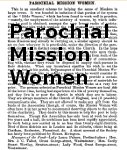 During his time in the parish he had two curates
(with grants of £80 for the senior and £40 for the junior from the
Curates' Aid Society, both of which he made up to £100 from his own
income), a team of district visitors, a Scripture Reader (paid by the
Scripture Readers' Society - was this a national or a diocesan body?),
a nurse for the sick-poor, financed by Mrs Jane Stuart-Wortley
and a 'parochial mission woman' paid by Lady Wood (wife of Sir William
Page Wood, MP for Oxford, briefly Solicitor-General, and then a
vice-chancellor of Oxford University) and the Parochial
Mission Society (see this 1863 report, right, from the [high-church] English Church Union Kalendar). So in comparison with other East End parishes, Christ Church was
well-staffed, but funding for church and schools was always precarious,
and depended on charitable-well wishers (including Miss Chapman)
rather than official sources of income. In his 13 years in the parish
McGill raised £26,000 from private sources; but there was no
fixed endowment, only pew rents of about £250 (falling) and sporadic
collections of about £15 a year.
During his time in the parish he had two curates
(with grants of £80 for the senior and £40 for the junior from the
Curates' Aid Society, both of which he made up to £100 from his own
income), a team of district visitors, a Scripture Reader (paid by the
Scripture Readers' Society - was this a national or a diocesan body?),
a nurse for the sick-poor, financed by Mrs Jane Stuart-Wortley
and a 'parochial mission woman' paid by Lady Wood (wife of Sir William
Page Wood, MP for Oxford, briefly Solicitor-General, and then a
vice-chancellor of Oxford University) and the Parochial
Mission Society (see this 1863 report, right, from the [high-church] English Church Union Kalendar). So in comparison with other East End parishes, Christ Church was
well-staffed, but funding for church and schools was always precarious,
and depended on charitable-well wishers (including Miss Chapman)
rather than official sources of income. In his 13 years in the parish
McGill raised £26,000 from private sources; but there was no
fixed endowment, only pew rents of about £250 (falling) and sporadic
collections of about £15 a year.
In addition to his poor-law activites mentioned above, here
are four documents from his time, showing him to be an astute and well-organised pastor:
| Sundays 11am,
3.30pm and 6.30pm; Wednesdays, Fridays and holy days 11am; Wednesdays
in Lent 7pm; Holy Communion last Sunday of the month and greater
festivals, and quarterly at 6.30pm*; School-Church 11am and 6.30pm; Ragged School Sunday 7pm, Thursday 8pm |
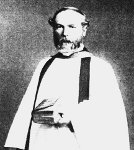 James
Maconechy
(Vicar 1868-71) was the son of James Machonechy MD (1796-1866), member
of the Faculty of Physicians and Surgeons in Glasgow, a literary author
and for 23 years editor of the (long-defunct) journal the Glasgow Courier. After Balliol, he served curacies in Sonning (Reading), Kensington and St George
Hanover Square (where William Quekett thought he had been going!) before his appointment here. His first
challenge in the East End was a noisy congregation, with young people courting
invisibly in the high-backed gallery pews, and sidesmen struggling to
keep order. He dealt with this - but at the cost of losing the young
people. He made the customary but controversial 'innovations' of the
time - a choral service with a surpliced choir, the Litany as
a separate service and the new-fangled Harvest Festival (which became
very popular). He also abolished some pew rents in
favour of a
weekly offertory; this was less successful, as it was about this time
that the better-off began to move
away
from the area. In his time the chancel was created,
as
explained
above. He complained when he came that the most prominent object
in the church was the pulpit, secondly the reading desk and thirdly
the clerk's desk.
James
Maconechy
(Vicar 1868-71) was the son of James Machonechy MD (1796-1866), member
of the Faculty of Physicians and Surgeons in Glasgow, a literary author
and for 23 years editor of the (long-defunct) journal the Glasgow Courier. After Balliol, he served curacies in Sonning (Reading), Kensington and St George
Hanover Square (where William Quekett thought he had been going!) before his appointment here. His first
challenge in the East End was a noisy congregation, with young people courting
invisibly in the high-backed gallery pews, and sidesmen struggling to
keep order. He dealt with this - but at the cost of losing the young
people. He made the customary but controversial 'innovations' of the
time - a choral service with a surpliced choir, the Litany as
a separate service and the new-fangled Harvest Festival (which became
very popular). He also abolished some pew rents in
favour of a
weekly offertory; this was less successful, as it was about this time
that the better-off began to move
away
from the area. In his time the chancel was created,
as
explained
above. He complained when he came that the most prominent object
in the church was the pulpit, secondly the reading desk and thirdly
the clerk's desk.
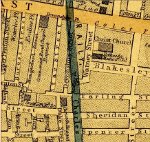 The
church responded to the shipbuilders' strike, when many skilled men had
moved elsewhere, leaving unskilled labourers in their wake, by laying
on twice-weekly sewing classes for the wives, with 200-300 attending at
church and the Middlesex Schools and receiving 6d. an hour for their
needlework, funds provided by the Mission and Relief Society. Meetings
ended with a short service and address. Halfpenny dinners were also
provided by the Destitute Children's Dinner Society. Help with
'migration' - to the north of England as well as Canada - was given:
see here and here for others who saw this as a 'solution'. He
succeeded McGill as Honorary Chaplain to the local Engineers, and
played a leading part in a London-wide mission in 1869, issuing an address to the parish: My
dear friends in Jesus Christ, is has pleased God to put into the hearts
of some of His servants to make at this time a great and united effort
for the conversion of sinners and the revival of true religion. For
twelve days we shall entreat God to turn men's hearts from sin to
Himself, and we shall also endeavour, by preaching and exhortations in
church, in schoolrooms, and in private rooms, to bring home the great
truths of the gospel ... (Compare the aversion of Harry Jones, Rector at St George's a few years later, to organised missions).
The
church responded to the shipbuilders' strike, when many skilled men had
moved elsewhere, leaving unskilled labourers in their wake, by laying
on twice-weekly sewing classes for the wives, with 200-300 attending at
church and the Middlesex Schools and receiving 6d. an hour for their
needlework, funds provided by the Mission and Relief Society. Meetings
ended with a short service and address. Halfpenny dinners were also
provided by the Destitute Children's Dinner Society. Help with
'migration' - to the north of England as well as Canada - was given:
see here and here for others who saw this as a 'solution'. He
succeeded McGill as Honorary Chaplain to the local Engineers, and
played a leading part in a London-wide mission in 1869, issuing an address to the parish: My
dear friends in Jesus Christ, is has pleased God to put into the hearts
of some of His servants to make at this time a great and united effort
for the conversion of sinners and the revival of true religion. For
twelve days we shall entreat God to turn men's hearts from sin to
Himself, and we shall also endeavour, by preaching and exhortations in
church, in schoolrooms, and in private rooms, to bring home the great
truths of the gospel ... (Compare the aversion of Harry Jones, Rector at St George's a few years later, to organised missions).
In his time
several initiatives were pioneered at Christ Church. A total
of 26 mission
rooms were hired around the parish, with house-to-house visitors
inviting people who would never come to church to attend evening
'cottage' services,
led by a large clergy and lay team. The first of these was at the Ragged School
at the southern end of
Devonshire [later
Winterton] Street, the worst and most populous street of the parish,
where Maconechy's predecessor had begun to hold services, led by a home missionary (see the comments in his 1861 census). The 1868 map - right - shows the location of 'Christ Church Ragged School' and 'Smith's Place Ragged School' [see below]; the blue line is the underground railway. (See here for the website of a Jewish family who moved into Winterton Street in 1901.).
There were schoolroom services at the railway arches school, teas for the 'unchurched'
(popular, but too costly to repeat) and open-air services of hymns and
preaching, especially in Holy Week. Here is an account from the high-church Church Herald of 27 April 1870:
| Christ Church, St. George's-in-the-East.
– Great praise is due to the Rev. J. Maconechy, Vicar of
Christ Church, St. George's-in-the-East, for the efforts he has made
daring his Incumbency to bring his congregation, and the poor of his
parish who never enter a Church, to value Church privileges. Throughout
Lent Mr. Maconechy had daily Morning and Evening Prayer at 8 a.m. and 6
p.m.; hymns, Litany and short Sermons on Wednesday and Friday evenings
at 8; and Celebration every Sunday at 9 a.m. The hours chosen for
Matins and Evensong we think were rather unfortunate, but especially
Evensong at 6, an hour when very few East-end people could attend,
consequently the attendance was small; but the fact that the Offices
were recited by the Clergy, even if no parishioners attended, was a
great point gained. The congregations at the Litany Services on
Wednesdays and Fridays were very encouraging. From the Pall Mall Gazette we learn how Good Friday was observed by Mr. Maconechy:– While the ordinary congregation were attending Morning Service in Church, the Vicar the Rev. J. Maconechy, and the Rev. J.F.N. Eyre, senior Curate, conducted a series of seven Services in various streets of the parish. Accompanied by the choir boys and several lay helpers, they started from a small Mission room in Devonshire-street, one of the worst streets in the metropolis. The Clergy wore their cassocks and black gowns, and were preceded by the choir, singing the hymn, 'Come, Holy Ghost, Creator, Come!' They took up their position at the foot of the street, where, after prayer, the first short Sermon, or address, was given. It was thought desirable, it is stated, not to take the 'Stations of the Cross', but to confine the addresses to the facts connected with the Crucifixion recorded in the Gospel, and more especially to our Lord's words from the Cross, one of which formed the subject of address in each of the seven streets to which the preachers moved in succession. Mr Maconechy spoke on the first and fourth utterances, 'Father, forgive them', and 'Eli' Eli' lama sabachthani?' Mr. Eyre on the third and seventh, ' Woman, behold thy Son', and 'Father, into Thy hands I commend My spirit'; while the remaining addresses were given by two laymen - Captain Dawson, R.N., and Mr. R. Thomas, of the East London Collegiate School. Each address was preceded by a suitable hymn, and followed by an extempore prayer, offered up by one of the Clergy or by a Scripture-reader or City missionary. In moving from street to street the well known hymn, ' When 1 survey the wondrous Cross', was sung on every occasion, and was heartily joined in by the people, among whom copies of the Christian Knowledge Society's Hymnal were distributed. The other hymns were such well-known ones as 'Rock of Ages', and 'There is a fountain filled with blood'. The last address was delivered opposite the Church, and those present were invited into Church, where the Service was ended with the Litany. It is said that nothing could exceed the quietness and decorum with which the Services were received in the various streets. Everywhere the addresses were listened to with marked attention, not only by the bystanders, but by many at the windows of the houses. Mr Lowder had a Service of a more profound character. |
Evangelical Christendom of 2 May 1870 includes the same account, also approvingly but prefaced with these words which assume, wrongly, that Maconechy was an evangelical:
| OUTDOOR PREACHING ON GOOD FRIDAY On Good Friday last year there was a Ritualistic procession in the East of London with outdoor services. This year simultaneously with similar semi-Romish proceedings, an Evangelical clergyman made an experiment of a somewhat novel character in the district parish of Christ Church, St. George's-in-the-East, in order to bring before the mass of the people the great facts of Good Friday.... |
All of this was moderately
successful, but very hard to sustain. The
Rev H.W. More Molyneux, a Surrey curate, came up for two days each week
to lead this work; the Rev G.P. Ottey also responded to an appeal for
help (see here for details of his brief time as curate, and his cricketing career).
 Then, from 1871-93, Maconechy was the Vicar of All Saints,
Norfolk Square in Paddington, a wealthy parish carved out of St James Sussex Gardens, with a Commissioners' church of 1847 by Clutton. Here, according to the high-church weekly Church Herald, he succeeded in thoroughly restoring [i.e. adapting - by creating a quasi-chancel with clergy and choir stalls] his
church ... and of introducing Catholic services. Under the direction of
Mr. Brooks, the architect, the western gallery has been removed, and
the organ moved ... (After
his departure, All Saints burned down in 1894; it was
rebuilt to designs by Ralph Nevill, but closed in 1919, when the parish
was joined to St Michael & All Angels Paddington, and was
subsequently demolished. The later picture [right] ) shows that it remained firmly in the anglo-catholic tradition.) He served on the local
committee of the Charity Organisation Society; according to its Reporter, and in line with its principles, he wrote to The Times
in 1882 suggesting that out-patients at charity hospitals in the
metropolis should pay a nominal shilling, and in-patients half a crown,
which would raise four-fiths of their reported annual deficit of
£75,000. In 1879, according to the National Schoolmaster, he was rebuked for his action in expelling a child from the parish school, according to this letter:
Then, from 1871-93, Maconechy was the Vicar of All Saints,
Norfolk Square in Paddington, a wealthy parish carved out of St James Sussex Gardens, with a Commissioners' church of 1847 by Clutton. Here, according to the high-church weekly Church Herald, he succeeded in thoroughly restoring [i.e. adapting - by creating a quasi-chancel with clergy and choir stalls] his
church ... and of introducing Catholic services. Under the direction of
Mr. Brooks, the architect, the western gallery has been removed, and
the organ moved ... (After
his departure, All Saints burned down in 1894; it was
rebuilt to designs by Ralph Nevill, but closed in 1919, when the parish
was joined to St Michael & All Angels Paddington, and was
subsequently demolished. The later picture [right] ) shows that it remained firmly in the anglo-catholic tradition.) He served on the local
committee of the Charity Organisation Society; according to its Reporter, and in line with its principles, he wrote to The Times
in 1882 suggesting that out-patients at charity hospitals in the
metropolis should pay a nominal shilling, and in-patients half a crown,
which would raise four-fiths of their reported annual deficit of
£75,000. In 1879, according to the National Schoolmaster, he was rebuked for his action in expelling a child from the parish school, according to this letter:
| Sir,-
On the 7th August last your board brought under their lordships' notice
the case of a child named Alice Willsher, who had been dismissed from
the All Saints' School, Paddington, for having absented herself from
the school of the day of inspection. My lords have been in
communication with the Rev. J. Maconechy, the correspondent for the
school, from whose letters it appears that the child had been expressly
warned by the pupil-teacher, and had been present when the mistress had
more than once given public notice that the inspection was about to
take place on the day in question, and that all the children must
attend. The managers considered that if the father was not aware that
he was keeping his child away from the inspection it could have only
been from her purposely omitting to tell him, and that, therefore, her
absence was wilful and deliberate, and an act of disobedience. It was,
moreover, a distinct breach of the law, as the bye-laws specially
required the attendance of all the children on that day. Under
these circumstances, my lords informed Mr. Maconechy that they looked
upon expulsion as an extreme measure, that they were unwilling to
sanction, even in the case of so serious an offence as wilful absence
from the inspection ... |
His first wife wife Laura Sophia, a General's
daughter, died in 1872, and two years later he married Henrietta Clara Marion Baillie, great-niece of the Scottish writer Joanna Baillie; they had a daughter, but Henrietta died in 1878.
On
his departure, having provided cover for a while at Christ Church
Cheltenham (a town which is something of an evangelical stronghold),
from 1893-96 he was Rector of Wiggonholt with Greatham in Sussex. He
was received into the Roman Catholic Church in 1901, in Cheltenham. In
a footnote to an article in The Record entitled 'Perverts [sic!] to Rome: Who and Whence?' - arguing that not all converts were Anglo-Catholics - A.R. Buckland says The
case of the Rev. James Maconechy, a recent pervert, has been made much
of. It is understood that Mr. Maconechy, who was ordained in 1858, was
for many years a Moderate Churchman; but, as he has held no cure since
1896, the general public have no means of knowing through what process
of development he has passed in recent years.
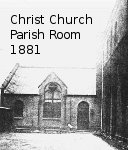 William
Pimblett Insley
(Vicar 1871-80) was born in Warrington; he also came here, after Wadham
College Oxford (a 4th class degree), and curacies in Yorkshire (Kirk
Ella and Flixborough), via the West
End (Christ Church Chelsea). As he arrived, the parish boundaries were
adjusted slightly. He continued work on the church, re-pewing it,
adding a new pulpit and restoring the organ. He started a temperance
society, a cricket club and a drum and fife band. A room in Buross
Street was hired, next to a pub; here Miss Rose began a night school
for girls in 1877 and a women's bible class in 1879.
William
Pimblett Insley
(Vicar 1871-80) was born in Warrington; he also came here, after Wadham
College Oxford (a 4th class degree), and curacies in Yorkshire (Kirk
Ella and Flixborough), via the West
End (Christ Church Chelsea). As he arrived, the parish boundaries were
adjusted slightly. He continued work on the church, re-pewing it,
adding a new pulpit and restoring the organ. He started a temperance
society, a cricket club and a drum and fife band. A room in Buross
Street was hired, next to a pub; here Miss Rose began a night school
for girls in 1877 and a women's bible class in 1879.
In 1871 he wrote to the National Schoolmaster
| A
short time since I advertised in your columns for a non-resident
governess to instruct my two little girls on five half-days a week, and
requested applicants to state the salary required. Fearing lest I might
fail in my object, I had the advertisement inserted in two successive
issues of your paper. But I had grievously miscalculated the
circulation of the Standard, and the number of its readers. Within two
or three hours after the first appearance of my advertisement I
received my first reply; and for two days the stream continued to flow
without intermission. On every round the postman called at my house
with handfuls of letters, which he dealt out like packs of cards; while
a dozen or so of the more determined applicants, probably rendered more
alive to the exigencies of place-hunting by previous ill-success,
called upon me, either personally, or in the person of an interested
friend. I received answers from the daughters of clergymen and
solicitors; answers in French and English: answers answers on paper
pink, white, green, and black edged; answers from ladies in the north,
south, east, and west of London; some of them prepared to come over
daily from Putney and Hammersmith, a distance of certainly not less
than seven miles from my house; answers offering to undertake the
duties for any sum from £10 per annum to £50, though the majority
seemed to think £20 or £25 an adequate return for their labours. I felt
pained, indeed, to cause disappointment to so many, and should have
been glad if I could have offered a post to each of them; but I
wanted one governess — not a hundred — so the thing was obviously
impossible. At first I attempted to acknowledge each reply in writing,
but when the second and third batches of letters came I gave it up;
and, ultimately, not wishing to show a want of courtesy to those who
had been so kind as to write to me, I had a short circular printed and
sent to each one in a stamped wrapper. As they are all readers of your
paper, I trust this letter will meet their eye, and that when they see
it they will pardon the tardy and, apparently, curt answer they
received. |
As explained here, in
1877 the Middlesex Schools were taken over by Raine's Foundation
(as a result of the 1870
Education Act). This meant that Christ
Church lost much of its educational clout, and the attendance of
scholars at church in their charity uniforms; but Mr Insley ensured
that the scheme provided £600 towards the building
of a hall
next to the church in the vicarage gardens, known as Dean [now
Deancross] Street Mission Room - right. It
was opened by
Bishop
Walsham How, Bishop of Bedford (the first 'bishop for East London') in
1881. The Sunday School of 500
scholars transferred from the railway arches, as did some of the Buross
Street work; a senior boys club was started.
| The 'Churches' section of Charles Dickens Jr's Dictionary of London (1879) lists the Sunday services as 11am Matins, Litany & Ante-Communion, 6.30pm Evensong (with Holy Communion on the 2nd Sunday at 8pm), with Matins on Wednesdays and Fridays at 11am. 'Anglican music' was used, and the hymnbook was Ancient & Modern. |
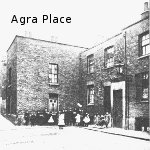
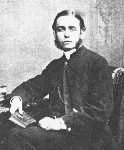 Alfred
Leedes Hunt
(Vicar 1880-83), born in Ipwich, was a former scholar of St John's
College Cambridge,
and had worked in Islington and Spitalfields. He married around the
time he came to Christ Church, and had three children. He arranged for
the church to
take over the small school at the southern end of Devonshire Street run by the Ragged
School
Union (now the Shaftesbury
Society),
where the parish had held Sunday evening services for some years. This
was supported by a fund created by Charles and Maria Sterry (parents of
the
next Vicar's wife - he was chief clerk at the Mint). The
need for such schools had declined with the coming of public funding
for education under the 1870 Act. The school was closed, and the fund
supported work at a mission room in Smith's Place [later renamed Agra
Place - pictured]
which Harry Jones at St George's had started. Buross Street activities
also moved here, as that room was required by the landlord. Another
mission centre was set up in an old cottage in Joseph Street (off Cannon Street Road). The East
London Church Fund made a grant of £150 for a curate, and a
few
years later a further £50 (matched by the Duke of
Westminster)
for a second one. (See 1868 map referred to above for the location of these sites.)
Alfred
Leedes Hunt
(Vicar 1880-83), born in Ipwich, was a former scholar of St John's
College Cambridge,
and had worked in Islington and Spitalfields. He married around the
time he came to Christ Church, and had three children. He arranged for
the church to
take over the small school at the southern end of Devonshire Street run by the Ragged
School
Union (now the Shaftesbury
Society),
where the parish had held Sunday evening services for some years. This
was supported by a fund created by Charles and Maria Sterry (parents of
the
next Vicar's wife - he was chief clerk at the Mint). The
need for such schools had declined with the coming of public funding
for education under the 1870 Act. The school was closed, and the fund
supported work at a mission room in Smith's Place [later renamed Agra
Place - pictured]
which Harry Jones at St George's had started. Buross Street activities
also moved here, as that room was required by the landlord. Another
mission centre was set up in an old cottage in Joseph Street (off Cannon Street Road). The East
London Church Fund made a grant of £150 for a curate, and a
few
years later a further £50 (matched by the Duke of
Westminster)
for a second one. (See 1868 map referred to above for the location of these sites.)
Mr Hunt was also a committee member of
the Charity Organisation Society, and a local Board Schools manager. His handwriting (in the registers) was neat but tiny! He had
another
attempt at abolishing pew rents, keeping collections on the first
Sunday for himself in
lieu! But he became seriously ill and was
told to leave London. For four years he was Rector of New Maldon, and then from 1897 of East Mersea, where he
succeeded Sabine
Baring Gould (who while there had used the local
landscape in Mehalah:
A Story of the Salt Marshes).
It was said that the 'islanders' preferred Hunt to Gould because he was
more
low
church and accessible. Here he wrote a commentary Ruth the Moabitess (1901) for Sunday School teachers, and was
a diocesan inspector of schools. Reflecting the church's renewed
enphasis on confirmation, he produced various manuals over the years: What mean ye by this service? - a question to those who are coming forward to confirmation (1885); Helps and Hindrances: words of counsel and encouragement to those newly confirmed (1885); The King's Table of Blessing: Thoughs for Communicants (1895); and Unto life's end; or, before and after confirmation (1909). From
1903-19 he was Rector of Great Snoring in Norfolk, and Rural Dean of
Walsingham for his last six years there. His final incumbency was of
Moreton in Essex, from where he retired to Cambridge in 1923, having
permission to officiate in Chelmsford and Ely dioceses; in retirement
he published Evangelical By-paths: Studies in the religious and social aspects of the evangelical revival of the 19th century, and David Simpson and the Evangelical Revival (both 1927). He died in 1936, aged 83.
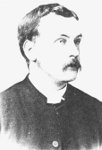
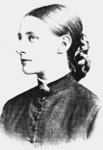 Willie
Parkinson Jay
(Vicar 1883-89) after St Catherine's College Cambridge, he had served his title at St George's, running
the work at Smith's Place, and came after a second curacy in Hackney. He
too was an advocate
of the methods of the Charity Organisation Society,
administering help 'in strict combination' with the organisation and
serving on its local committee. He was also a member of the London School Board from 1885 until he left the parish. His flamboyant brother Arthur Osborne
Montgomery Jay was Vicar of Holy
Trinity, Shoreditch from 1886, serving the slums of the notorious Old
Nichol and creating a boxing club in the church
basement; see here for an account (with corrections) of his ministry there.
Mr
Jay and his wife offered a less controversial, but equally innovative,
style of ministry at
Christ Church. As well as supervising the provision of halfpenny
dinners (41,000 pints of soup one winter) and running the Mothers'
Meeting (which had run for more than 20 years - there were 100 members in 1861), Mrs Jay is credited with
creating the first ever Fathers' Meeting. Bishop Walsham How was
an
honorary member, and after a visit in February 1888 a member sent him a
pair of red leather slippers with this letter:
Willie
Parkinson Jay
(Vicar 1883-89) after St Catherine's College Cambridge, he had served his title at St George's, running
the work at Smith's Place, and came after a second curacy in Hackney. He
too was an advocate
of the methods of the Charity Organisation Society,
administering help 'in strict combination' with the organisation and
serving on its local committee. He was also a member of the London School Board from 1885 until he left the parish. His flamboyant brother Arthur Osborne
Montgomery Jay was Vicar of Holy
Trinity, Shoreditch from 1886, serving the slums of the notorious Old
Nichol and creating a boxing club in the church
basement; see here for an account (with corrections) of his ministry there.
Mr
Jay and his wife offered a less controversial, but equally innovative,
style of ministry at
Christ Church. As well as supervising the provision of halfpenny
dinners (41,000 pints of soup one winter) and running the Mothers'
Meeting (which had run for more than 20 years - there were 100 members in 1861), Mrs Jay is credited with
creating the first ever Fathers' Meeting. Bishop Walsham How was
an
honorary member, and after a visit in February 1888 a member sent him a
pair of red leather slippers with this letter:
| Dear
fellow Farther, We are members of one farthers meeting held at Christ Church, Watney Street, and we long to see you with us again. I do not forget your address when you last came. We were all very much disopointed on Boxing Night. We did expect you, do come as soon as you can. Will you axcept of this little present from me as a fellow farther, belonging to the sam meeting as yourself, and I am glad to be able to say belonging to the sam Saviour and looking forward to the sam rest at last. Yours truly, J.G. |
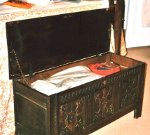 Mrs Jay's grand-daughter (whose help and
encouragement we gratefully acknowledge) has a
blanket chest presented
to Mrs Jay by the
members of the Christ Church Dorcas Society July 1889 - still used for its
original purpose [pictured right].
Mrs Jay's grand-daughter (whose help and
encouragement we gratefully acknowledge) has a
blanket chest presented
to Mrs Jay by the
members of the Christ Church Dorcas Society July 1889 - still used for its
original purpose [pictured right].
The Bishop of Bedford was also present in 1886 for a royal visit to an exhibition mounted by Christ Church Working Lads' Club. That year, a thousand musicians, mostly in uniform, marched to the church for
the annual demonstration of the bands of East London, where after a
short service the Bishop of London addressed them (Frank Leslie's
Sunday Magazine 1886 p31).
It
was in 1888 that the decorative scheme of the church was completed,
'cheaply [£1400] and in good taste' said Dimsdale [below] whose
book describes everything in great detail. He also completed the task
of abolishing pew rents, making all seats 'free and unappropriated' -
despite the fact that the living was still poorly endowed.
In
1882 he married
Mary Catherine Watson, daughter of Thomas Watson JP, Fellow of the
Royal Astronomical Society and president of the Cape Town Chamber of
Commerce - and a campaigner for a telegraphic landline to Europe.
[Other
sources wrongly describe him as 'Sir Thomas' and 'the premier'; she was
also said to be a great-grand-daughter of Lord Saltoun on her mother's
side.]
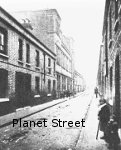 Returning from South Africa, in
his short time at Christ Church he set in motion the building of Planet
Street Institute [right],
using most of the £3220 paid in
the form
of stocks by the London and Blackwall Railway for the arches site - the
rest was held as a maintenance fund (and still features in our parish
accounts). Planet Street,
Returning from South Africa, in
his short time at Christ Church he set in motion the building of Planet
Street Institute [right],
using most of the £3220 paid in
the form
of stocks by the London and Blackwall Railway for the arches site - the
rest was held as a maintenance fund (and still features in our parish
accounts). Planet Street, 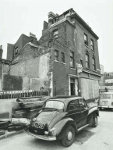 known from 1865-91 as Star Street, was possibly
the grimmest in the area, and was described in detail by John
Hollingshead in Ragged London
(1861): its road is black and muddy, half filled with pools of inky water; he describes a room inhabited by a chimney sweep with two women, and infant and two children playing on the black floor ... eating what is literally bread and soot. Two
other rooms had nine dwellers, and two more eleven each. The average
rent of the 63 two-up, two-down houses in the street was 1s. 9d. and they
housed 252 families; the average room size was 9' 5" square, the height
8' 5". In Hare's time the adjoining Star Place (six houses) acquired
notoriety for Jack the Ripper connections: it's possible that Elizabeth Stride (who lived in Devonshire Street, the next one along) and Martha Tabram drank at The Star,
2 Morris [previously 22 Duke] Street, on the corner of Star Place. The
pub continued at least until the 1930s, allegedly as a haunt of
transvestites, gangsters and gamblers [right around
1971]. Peter
Kurton writes that a number of Lithuanians, including his own
ancestors,
settled in and around this street from the 1890s, and ran 'cottage
industries' from their homes. He feels that they may have been lumped
together as 'Russians' (since Lithuania was under Russian control),
though in fact they were Catholics with a distinct
identity, and had their own place of worship - originally in Cable Street, and then (and still today) in Bethnal Green. Our thanks to Peter for this and other information about his family.
known from 1865-91 as Star Street, was possibly
the grimmest in the area, and was described in detail by John
Hollingshead in Ragged London
(1861): its road is black and muddy, half filled with pools of inky water; he describes a room inhabited by a chimney sweep with two women, and infant and two children playing on the black floor ... eating what is literally bread and soot. Two
other rooms had nine dwellers, and two more eleven each. The average
rent of the 63 two-up, two-down houses in the street was 1s. 9d. and they
housed 252 families; the average room size was 9' 5" square, the height
8' 5". In Hare's time the adjoining Star Place (six houses) acquired
notoriety for Jack the Ripper connections: it's possible that Elizabeth Stride (who lived in Devonshire Street, the next one along) and Martha Tabram drank at The Star,
2 Morris [previously 22 Duke] Street, on the corner of Star Place. The
pub continued at least until the 1930s, allegedly as a haunt of
transvestites, gangsters and gamblers [right around
1971]. Peter
Kurton writes that a number of Lithuanians, including his own
ancestors,
settled in and around this street from the 1890s, and ran 'cottage
industries' from their homes. He feels that they may have been lumped
together as 'Russians' (since Lithuania was under Russian control),
though in fact they were Catholics with a distinct
identity, and had their own place of worship - originally in Cable Street, and then (and still today) in Bethnal Green. Our thanks to Peter for this and other information about his family.
His wife Mary died in 1897 (in Bournemouth), and in 1901 he left rather suddenly (press reports spoke of a mysterious disappearance from the East End) to visit the USA, where he became incumbent of St Paul Albany, and the following year Rector of St George Toronto. Four years later he was Rector of All Saints Milford, in Connecticut, and in 1907 became Dean of Grace Cathedral in Davenport, Iowa, which soon after joined with Trinity church (built 1873) as Trinity Cathedral - he was, apparently, acceptable to both congregations. In 1910 he re-married:
| This morning (28 June) at 11 o'clock took place the marriage of Very Rev.
Marmaduke Hare, dean of Trinity cathedral, Davenport, and Miss Anna
Lyster, daughter of Mr. and Mrs. Armstrong B. Lyster of Lyster island,
near Breedsville, Mich., the ceremony taking place at St. Peters
Episcopal church, Chicago. The Very Rev. T. N. Morrison, bishop of Iowa
and head of the church with which Dean Hare is connected, officiated.
The bridal couple was unattended and the ceremony was witnessed by a
small company of relatives and near friends, the decorations and
appointments being simple. Following the ceremony Dean Hare and his
bride left for an extended wedding trip to the Pacifio coast. On their
return they will reside at the New Kimball till fall when they will go
to housekeeping in the Kiser house on Perry street. The bride is of an old English family, her grandfather having been governor of Nova Scotia, coming there from England, and she is a woman of culture and education. Mrs. William Kiser, of Salt Lake City, is a cousin and it was while visiting at her home that Dean Hare met his bride-elect. Dean Hare has been in this country nine years, coming here from England. In east London he had been associated with the leading dignitaries of his church and was acquanited with men and women in high court circles ... He is a man of broad knowledge, having travelled extensively, being a chaplain in the Congo war, and withall a brilliant man. Mrs Hare will be heartily welcomed to tri-city [Davenport, Rock Island and Moline] society. |
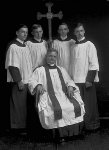
 In that same year, Billboard
announced that comedian William Collier had arranged by telephone to
marry the leading lady from his company Pauline Marr at the cathedral,
but when they arrived and the Dean discovered he was divorced he
was advised to take his affianced to the pastor of a church of
different denomination, as marriage under such circumstances was
contrary to the laws of the Episcopal faith. However, the report continued, Dean
Hare is an admirer of Mr. Collier as an actor, as was evidenced by his
attendance at his performance at the Grand Opera House. (Compare this account of the marriage of a divorcee in 1903 by R.H. Hadden, former curate of St George-in-the-East.)
In that same year, Billboard
announced that comedian William Collier had arranged by telephone to
marry the leading lady from his company Pauline Marr at the cathedral,
but when they arrived and the Dean discovered he was divorced he
was advised to take his affianced to the pastor of a church of
different denomination, as marriage under such circumstances was
contrary to the laws of the Episcopal faith. However, the report continued, Dean
Hare is an admirer of Mr. Collier as an actor, as was evidenced by his
attendance at his performance at the Grand Opera House. (Compare this account of the marriage of a divorcee in 1903 by R.H. Hadden, former curate of St George-in-the-East.)
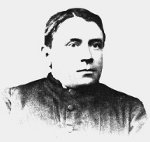
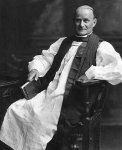 Henry
Cockfield Dimsdale
(1892-1909) was born in Palace Green Gardens, Kensington in 1856 and was a pupil at
Eton, leaving after four happy years because of serious illness.
After Trinity College Cambridge and a spell of foreign travel, he spent
a year at Leeds
Clergy School but left, to study law for a time. As a layman, he became
one of a
famous pioneering trio of Etonians at the college's temporary iron mission church in Hackney Wick, where Bodley's great church St Mary of Eton now stands. (The other two, both ordained, were Willy Carter [right], who began the mission and later became Bishop of Zululand, then of Pretoria, then Archbishop of Capetown; and Algy Lawley (also ex-Leeds Clergy School), who later served in various East and West End parishes, and became the 5th Baron Wenlock.) After
ordination and a further period of rest Dimsdale was appointed to Christ
Church.
Henry
Cockfield Dimsdale
(1892-1909) was born in Palace Green Gardens, Kensington in 1856 and was a pupil at
Eton, leaving after four happy years because of serious illness.
After Trinity College Cambridge and a spell of foreign travel, he spent
a year at Leeds
Clergy School but left, to study law for a time. As a layman, he became
one of a
famous pioneering trio of Etonians at the college's temporary iron mission church in Hackney Wick, where Bodley's great church St Mary of Eton now stands. (The other two, both ordained, were Willy Carter [right], who began the mission and later became Bishop of Zululand, then of Pretoria, then Archbishop of Capetown; and Algy Lawley (also ex-Leeds Clergy School), who later served in various East and West End parishes, and became the 5th Baron Wenlock.) After
ordination and a further period of rest Dimsdale was appointed to Christ
Church.
 When Planet Street Institute opened in 1892, Smith's
Place was closed and the Sterry Fund transferred. Most parish
activities moved here, and new ones
were started, including a Saturday School initiated by Miss Helen
Cunliffe (who was previously linked with the Sisters of the Church,
founded at
Kilburn in 1870, and now based at Ham Common; in 1895 she became
headmistress of Holy Cross School, Bournemouth so had presumably become
a Roman Catholic). This attracted about 200
children, pictured here in 1900, with a mixture of activities, play in
the vicarage
gardens, and an annual examination.
When Planet Street Institute opened in 1892, Smith's
Place was closed and the Sterry Fund transferred. Most parish
activities moved here, and new ones
were started, including a Saturday School initiated by Miss Helen
Cunliffe (who was previously linked with the Sisters of the Church,
founded at
Kilburn in 1870, and now based at Ham Common; in 1895 she became
headmistress of Holy Cross School, Bournemouth so had presumably become
a Roman Catholic). This attracted about 200
children, pictured here in 1900, with a mixture of activities, play in
the vicarage
gardens, and an annual examination.
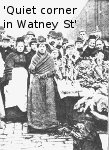
 The 1886
Census
of London church attendance, conducted on 24 October, had recorded
large congregations - 234 in the morning, and 254 in the evening. A
decade later, now with three curates (one of them, A.M. Cazalet,
secretary of the East
London Mission to the Jews), and a lay team of
locals and volunteers from further afield, plus two Clewer sisters, an
astonishingly busy weekly
programme was run - displayed, with a picture of the clergy team, here -
including twelve bible classes for
various groups which fed into the two main ones run by the vicar and
senior curate. The club for 'rougher girls' continued, as did one
long-standing 'cottage' meeting.
There was a communicants guild with four wards (St Alban, St Anne, St
George and the St Mary the Blessed Virgin); various men's activities,
including a Chapter of the Brotherhood of St Andrew, replaced the
Fathers' Meeting. 'Mr Elliott's Club' (the junior curate) met every
night of the week except Sundays; he clearly won the confidence of
those who, as Dimsdale put it, were verging on
criminality...possibly
the world would call them hooligans. And the number of
daily services
increased, with a daily eucharist. New vestries were built, and the
old one became a side chapel.
The 1886
Census
of London church attendance, conducted on 24 October, had recorded
large congregations - 234 in the morning, and 254 in the evening. A
decade later, now with three curates (one of them, A.M. Cazalet,
secretary of the East
London Mission to the Jews), and a lay team of
locals and volunteers from further afield, plus two Clewer sisters, an
astonishingly busy weekly
programme was run - displayed, with a picture of the clergy team, here -
including twelve bible classes for
various groups which fed into the two main ones run by the vicar and
senior curate. The club for 'rougher girls' continued, as did one
long-standing 'cottage' meeting.
There was a communicants guild with four wards (St Alban, St Anne, St
George and the St Mary the Blessed Virgin); various men's activities,
including a Chapter of the Brotherhood of St Andrew, replaced the
Fathers' Meeting. 'Mr Elliott's Club' (the junior curate) met every
night of the week except Sundays; he clearly won the confidence of
those who, as Dimsdale put it, were verging on
criminality...possibly
the world would call them hooligans. And the number of
daily services
increased, with a daily eucharist. New vestries were built, and the
old one became a side chapel.
For the third time patronage was transferred, this time to the Dean and and Canons of Canterbury (together with two other East End parishes), and the endowment increased by £300 through the voidance of All Hallows, Lombard Street to produce a stipend of £468, ending its claim of being the poorest parish in East London.
Watney Street remained a 'colourful' thoroughfare.
In Round London:
Down East and Up West Montagu Williams QC commented, in 1894,
| While acting as one of the magistrates of the Worship Street district it was a part of my duty to sit on certain days at the Thames Police Court. I found that the most convenient way to reach it from the West End was to go by the underground railway from Baker Street to Shadwell and proceed thence on foot. The distance from the railway station to the Court is an inconsiderable one but the best route is through Watney Street, which is the most disgraceful thoroughfare I was ever doomed to traverse. On either side of the way are poor, squalid shops. Throughout the day the road and the pavement are crowded with barrows laden with fish, vegetables, and other articles of food, cheap second-hand furniture, old iron, rabbit skins, and many articles besides. So great is the throng of dirty and ragged human beings that it is very difficult to make one’s way through the street. There is a good deal of unceremonious shoving in the crowd, but to remonstrate thereat would be to run a very good chance of being sent rolling in the gutter. A few policemen pick their way through the street, but I think they would be slow to incur the displeasure of such an evil-looking crowd. The stench in Watney Street is sickening. It arises for the most part from the greasy mash formed underfoot by the miscellaneous refuse from the barrows. Needless to say, this pandemonium contains a number of thriving public-houses. The women who infest the place are of a lower order than those to be met with in the Ratcliff Highway of to-day. When you gaze on their brutal and vicious faces, soddened with drink, you have a difficulty in believing that such beings are fellow human creatures. |
There
is an 1897 interview with
Dimsdale in the Booth
archive. In
that year, when his mother Catharine died, he and his sister gave
a set of gilt communion vessels (patens, cruets and chalice)
which we still use in festal seasons at St George-in-the-East.
In 1901 he wrote Sixty
Years'
History of an East End Parish, Christ Church, St.
George's-in-the-East (Henry
Bailey 1901), from which
much of the detailed information above is taken. The British
Archaeological Association patronisingly and stupidly hailed this book as a fine
example of what can be achieved even with a most unpromising subject, because modern
and poor. See here
for a brief account of a service at Christ Church attended by a
'reporter' for the Royal Commission on Ecclesiastical Discipline in
1904, and Dimsdale's equally brief response.
He married in 1909, at the age of 52, and had two children. An
intriguing remark
from his latter years was the
white motor
ambulance is almost as much as part of our city life as is the red
motor omnibus. He died in 1918, and was buried at Highgate Cemetery.
THE TWENTIETH CENTURY
See here for details of the curates from this period - including several who 'filled in' for short periods.Arthur
Stevens was
Vicar from 1909-16. Ordained in in 1882 in Durham where he had studied
at the university (as a non-collegiate member - a system instituted in
1871), he worked his way south with four further curacies along the
way, becoming Rector of St Mildred Canterbury
in 1896 (receiving a testimonial from his former parishioners in the
city). After two further incumbencies, in Burgess Hill and Kilburn, he
came to the parish at the age of 60. In retirement he held permission
to officiate in no less than six dioceses at various times, eventually
settling in St Leonards-on-Sea, where he died in old age.
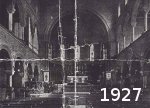 William
Holmes Shuter succeeded
him (1916-28); from county Tyrone (he played rugby football at
Dungannon Royal School), he trained at Trinity College
Dublin, was ordained in
Chester diocese in 1888 and was curate of Tarvin, then of Knutsford,
then of two parishes in Southwark diocese (St Luke Bromley Common and
St Michael Croydon) before coming to the parish, with a net stipend of
£358. (His father James Coote Shuter had died in 1914 at
Barnhill, Stewartstown in country Tyrone, leaving an estate of around
£5,000.) He retired to Herne Hill, living to a good age.
William
Holmes Shuter succeeded
him (1916-28); from county Tyrone (he played rugby football at
Dungannon Royal School), he trained at Trinity College
Dublin, was ordained in
Chester diocese in 1888 and was curate of Tarvin, then of Knutsford,
then of two parishes in Southwark diocese (St Luke Bromley Common and
St Michael Croydon) before coming to the parish, with a net stipend of
£358. (His father James Coote Shuter had died in 1914 at
Barnhill, Stewartstown in country Tyrone, leaving an estate of around
£5,000.) He retired to Herne Hill, living to a good age.
Right is the interior in 1927; see here for
the story of the shops and stalls of Watney Market next door.
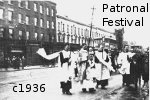

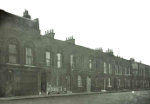 In
1929, when the church was in the doldrums and its future uncertain, St
John Beverley Groser was appointed as Vicar, on the basis that he could do little harm! In the event, he re-energised the parish, and the
remarkable story of
his ministry, at Christ Church and then at St George-in-the-East, is told here. One of the thurifers in those days was J.C.
(Jimmy) Mooney, now living in Colchester. He has fond memories of Frs
Groser and Boggis, who had the sad task of burying nine family members
killed in Blakesley Street during the Blitz (several other relatives
died in the Far East). For details of Fr Groser's curates, see here. (Blakesley Street was originally Upper and Lower John Street; right are 34-58, and 21-23 on the corner of Deancross Street, in 1958.)
In
1929, when the church was in the doldrums and its future uncertain, St
John Beverley Groser was appointed as Vicar, on the basis that he could do little harm! In the event, he re-energised the parish, and the
remarkable story of
his ministry, at Christ Church and then at St George-in-the-East, is told here. One of the thurifers in those days was J.C.
(Jimmy) Mooney, now living in Colchester. He has fond memories of Frs
Groser and Boggis, who had the sad task of burying nine family members
killed in Blakesley Street during the Blitz (several other relatives
died in the Far East). For details of Fr Groser's curates, see here. (Blakesley Street was originally Upper and Lower John Street; right are 34-58, and 21-23 on the corner of Deancross Street, in 1958.)
Dan Regan, who later was to become Director of Finance, and then Chief Executive, of the London Borough of Tower Hamlets, also lived in Blakesley Street - his family were members of St Mary & St Michael's Roman Catholic Church on Commercial Road. In 2011 he wrote
| As
a small boy, I and others used to creep into the church and ring the
bell until we were chased away by Fr Groser's wife. When I was 8, my
family and I were buried in the first raid on London on 7 September
1940. We were dug out by neighbours and taken to the London Hospital.
After a night and a day we went to stay with my uncle's mother-in-law
in Tait Street. During the continuing raids we went into the
shelter under the railway arch in Watney Street organised by Fr Groser
(thinking about it now, what a target for the bombers, under a
railway!) I later went to live with an aunt in Leytonstone, where we
were blitzed again, and I was evacuated to Norfolk and then
Buckinghamshire. All my childhood was spent in Church of England
schools where I was treated in a wonderfully Christian manner - so I
was ecumenical long before it became popular! We returned to Stepney in
1948 and lived in Stepney Way, then in Shadwell Gardens overlooking the
Cable Street fire station - coming full circle - before moving to
Bromley 40 years ago. When Stepney Rotary Club used to meet at the
Royal Foundation of St Katharine's I often talked to members of the
Community of the Resurrection about Fr Groser [see here for more details]. |

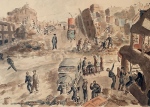
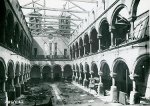 Church
and
vicarage were wrecked by a land-mine on 16 April
1941 [outside and inside left in 1943]. 'Next Day, Watney Street', a watercolour by Rose Henriques
[right], shows a policeman directing traffic, a wrecked tramcar being moved by a
'mechanical horse', one property marked 'for sale' and another
optimistically 'open as usual'. The congregation moved to St George-in-the-East, and the ruins of the church stood for some
years before
the site was cleared.
Church
and
vicarage were wrecked by a land-mine on 16 April
1941 [outside and inside left in 1943]. 'Next Day, Watney Street', a watercolour by Rose Henriques
[right], shows a policeman directing traffic, a wrecked tramcar being moved by a
'mechanical horse', one property marked 'for sale' and another
optimistically 'open as usual'. The congregation moved to St George-in-the-East, and the ruins of the church stood for some
years before
the site was cleared.
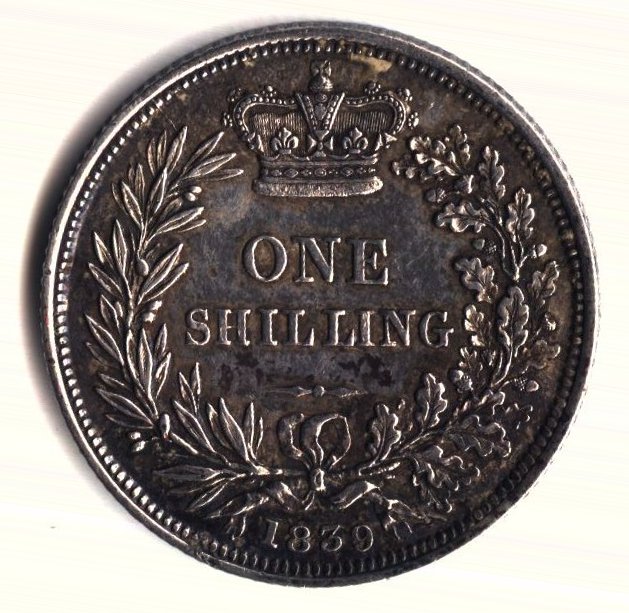
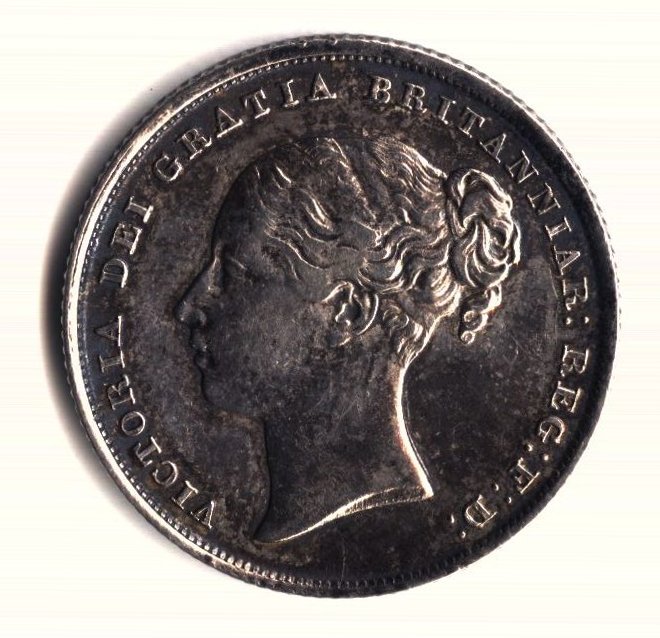 In 1952 the Archdeacon sent the Rector (by
recorded delivery) an 1839 shilling found under the foundation stone
during demolition, commenting I
am only sorry that we were not able to
unearth something more substantial in the way of treasure. The coin remains in our archives.
In 1952 the Archdeacon sent the Rector (by
recorded delivery) an 1839 shilling found under the foundation stone
during demolition, commenting I
am only sorry that we were not able to
unearth something more substantial in the way of treasure. The coin remains in our archives.
When
the parish of 'St George-in-the-East with Christ Church and St John'
was created in the 1950s, the area of the
parish east of
Watney Street, including the site of Christ Church and the parish room in Dean [now Deancross] Street, was
transferred to St Mary's
parish, but their residual funds remain in our parish accounts.
Homepage | About Us | Services & Events
| Church &
Churchyard |
History
Newsletters & Sermons | Contacts,
Links & Registers | Giving
| Picture
Gallery |
Site Map